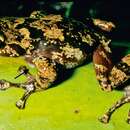Description
provided by AmphibiaWeb articles
M 24-29 mm, F 24-28 mm. Tympanum rather indistinct, 1/2 of eye diameter. Tibiotarsal articulation reaches at least the tympanum. Toe 3 as long as, or shorter than, toe 5. Forelimbs with spine-like projection in males. Skin smooth. Dorsal colour variable, brown with different dark or light markings. Ventrally whitish with black colour on the throat of males (Glaw and Vences 2007).Similar species: Larger than most other Anodonthyla (Glaw and Vences 2007).Taken with permission from Glaw and Vences (1994, 2007) and Nussbaum and Raxworthy (2008).
Nussbaum, R. and Raxworthy, C. (2008). Anodonthyla rouxae. In: IUCN 2008. 2008 IUCN Red List of Threatened Species. www.iucnredlist.org. Downloaded on 01 May 2009.
- author
- Miguel Vences
- author
- Frank Glaw
Distribution and Habitat
provided by AmphibiaWeb articles
Species has a very small range in south-eastern Madagascar, in the Anosy Mountains, at 1900m asl, which is close to the mountain summit at 1959m asl. It apparently does not occur at Andohahela (Nussbaum and Raxworthy 2008).
- author
- Miguel Vences
- author
- Frank Glaw
Life History, Abundance, Activity, and Special Behaviors
provided by AmphibiaWeb articles
Habits: Males call at night from high-elevational bamboo forest. Eggs in water-filled bamboo trunks of 1.5-2 cm diameter, guarded by the male (Glaw and Vences 2007). 13-50 eggs with a diameter of 2.5 mm in bamboo trunks and leaf axils of Pandanus were found (Glaw and Vences 1994).
- author
- Miguel Vences
- author
- Frank Glaw
Life History, Abundance, Activity, and Special Behaviors
provided by AmphibiaWeb articles
Species is listed as endangered because its extent of occurrence is less than 5000 km2, all individuals are in a single location, and there is likely to be continuing decline in the extent and quality of its bamboo forest habitat in southeastern Madagascar (Nussbuam and Raxworthy 2008).The main threat is likely to be habitat loss due to subsistence agriculture, timber extraction, charcoal manufacture, spread of invasive eucalyptus, livestock grazing, fires, and expanding human settlements. However, as a mountain-top species, it could also be at risk from global warming (Nussbuam and Raxworthy 2008).It is not known to occur in any protected areas, and the habitat of the Anosy Mountains is in urgent need of protection (Nussbuam and Raxworthy 2008).
- author
- Miguel Vences
- author
- Frank Glaw
Anodonthyla rouxae: Brief Summary
provided by wikipedia EN
Anodonthyla rouxae is a species of frogs in the family Microhylidae. It is endemic to Madagascar. Its natural habitat is subtropical or tropical moist montane forests. It is threatened by habitat loss.
- license
- cc-by-sa-3.0
- copyright
- Wikipedia authors and editors

